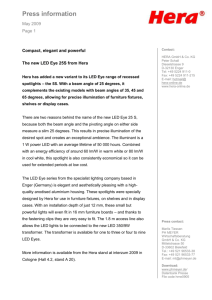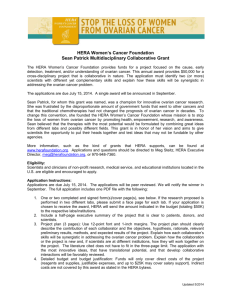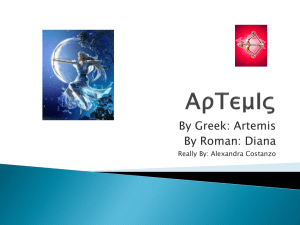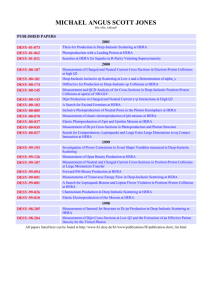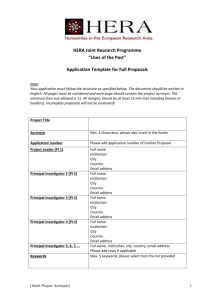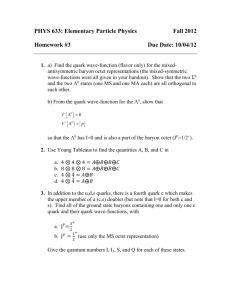2. First results on light quark couplings to the Z0 - HAL
advertisement
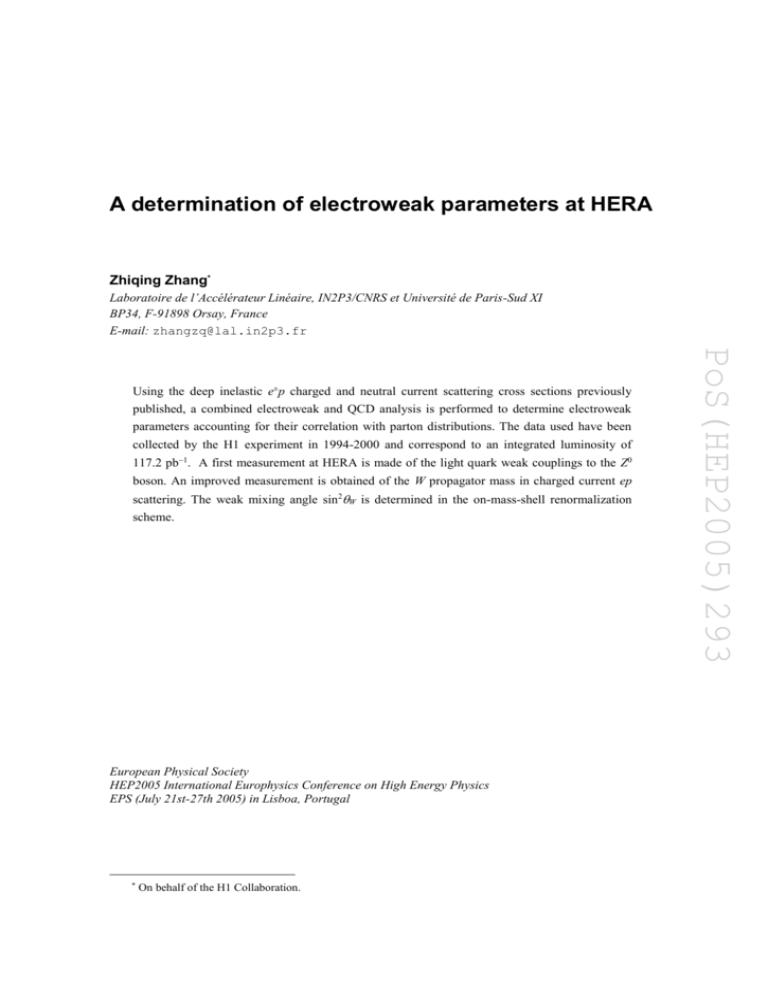
A determination of electroweak parameters at HERA Zhiqing Zhang* Laboratoire de l’Accélérateur Linéaire, IN2P3/CNRS et Université de Paris-Sud XI BP34, F-91898 Orsay, France E-mail: zhangzq@lal.in2p3.fr published, a combined electroweak and QCD analysis is performed to determine electroweak parameters accounting for their correlation with parton distributions. The data used have been collected by the H1 experiment in 1994-2000 and correspond to an integrated luminosity of 117.2 pb1. A first measurement at HERA is made of the light quark weak couplings to the Z0 boson. An improved measurement is obtained of the W propagator mass in charged current ep scattering. The weak mixing angle sin2W is determined in the on-mass-shell renormalization scheme. European Physical Society HEP2005 International Europhysics Conference on High Energy Physics EPS (July 21st-27th 2005) in Lisboa, Portugal * On behalf of the H1 Collaboration. PoS(HEP2005)293 Using the deep inelastic e±p charged and neutral current scattering cross sections previously 1. The experimental facts and analysis strategies 2. First results on light quark couplings to the Z0 boson at HERA The sensitivity on the quark couplings at HERA stems from the Z interference and Z0 exchange contributions in NC interactions at high Q2. The results of the combined au-vu-ad-vdPDF fit are shown in Fig.1 and compared with similar results obtained recently by the CDF experiment [5] and combined LEP experiments [6]. The HERA determination has comparable precision to that from the Tevatron. These determinations are sensitive to u and d quarks separately, contrary to other measurements of the light quark-Z0 couplings in N scattering [7] and atomic parity violation [8] on heavy nuclei. They also resolve any sign ambiguity and the ambiguities between vq and aq (q=u,d) of the determinations based on observables measured at the Z0 resonance [6]. The HERA precision is expected to improve significantly with the data from HERA-II taken at higher luminosity. The longitudinally polarized e± beams at HERA-II will also provide additional sensitivity in constraining the vector couplings vq. PoS(HEP2005)293 In the first phase of HERA operation (HERA-I) with the unpolarized e± beam colliding with the proton beam, the H1 experiment has collected three major data samples of e+p in years from 1994 to 1997 at a center-of-mass energy of 301 GeV, ep in 1998-1999 and e+p in 19992000 at 319 GeV. The corresponding integrated luminosities are 35.6 pb1, 16.4 pb1 and 65.2 pb1, respectively. These data have been used to measure neutral current (NC) and charged current (CC) cross sections covering more than 4 orders of magnitude in both Q2, the negative four-momentum transfer squared, and Bjorken x. The large kinematic coverage and the different flavor sensitivity of the e±p NC and CC cross section data have enabled 5 sets of parton distribution functions (PDF) to be determined simultaneously in a previous QCD analysis [1]. These five PDF sets are the gluon, up-type and down-type quarks and their anti-quarks distributions. The inclusive NC and CC cross sections are not only sensitive to PDFs but also to electroweak (EW) parameters. Indeed, the NC cross sections at high Q2 depend on up- and down-type quark couplings to the Z0 boson, aq and vq (q=u, d), via structure functions, whereas the shape of the CC cross sections as a function of Q2 is controlled by the propagator mass (Mprop) of the W boson. It is thus natural to extend the QCD analysis of [1] into a combined EWPDF analysis so that EW parameters can be determined together with the PDFs taking properly into account the small but non-negligible correlation between them. This is precisely the strategy chosen in [2,3], namely using the same parameterization forms for the five PDF sets for the QCD part. The QCD analysis is performed using the DGLAP evolution equations [4] at next-to-leading order in the modified minimal subtraction renormalization scheme. All quarks are taken as massless. Several combined EW-PDF fits are performed either in a model independent way (fits au-vu-ad-vd-PDF and G-Mprop-PDF) or within the Standard Model (SM, fits MW-PDF and mt-PDF). 3. Improved W propagator mass measurement at HERA The cross section data allow a simultaneous determination of the Fermi coupling constant GF and the W boson mass, and of the PDFs (G-Mprop-PDF fit). When treating G and Mprop as independent parameters, the sensitivity on G and Mprop originates respectively from the normalization and Q2 dependence of the CC cross sections. The result of the fit is shown in Fig.2 as the shaded area. FIGURE 2. The result of the fit to G and Mprop at 68% confidence level (CL) shown as the shaded area. The world average values are indicated with the star symbol. Fixing G to GF, the fit results in a measurement of the propagator mass Mprop shown as the circle with the horizontal error bar. PoS(HEP2005)293 FIGURE 1. H1 results (shaded area) at 68% confidence level (CL) on the couplings of u quark (left) and d quark (right) to Z0 in comparison with similar results from CDF (dashed curves) and LEP (full curves). Fixing G to the measured GF value [9], one gets a determination of Mprop, also shown in Fig.1, M prop 82.87 1.82exp 0.30 0.16 |model GeV where the first error is experimental and the second corresponds to uncertainties due to input parameters and model assumptions as introduced in Table 5 in [1] (e.g., the variation of s=0.1185±0.0020). This determination differs from all previous ones in the treatment of the correlation between Mprop and PDFs and represents the most accurate measurement so far of the CC propagator mass at HERA. Within the SM, the Fermi coupling constant GF is connected with the W boson mass MW through a relation which contains EW radiative corrections including quadratic (logarithmic) dependence on the top quark mass mt (the Higgs mass MH). A combined EW-PDF fit in the SM gives MW 80.786 0.205exp 0.048 0.029 |model 0.025 mt 0.084 M H 0.033 ( r ) GeV (1) sin 2 W 0.2151 0.00400.0019 0.0011 where the first error is experimental and the second is theoretical covering all remaining uncertainties in Eqn.(1). The uncertainty due to MZ is negligible. Fixing MW to the world average value and assuming MH=120GeV, the fit mt-PDF gives mt=108±44GeV where the uncertainty is experimental. The result represents the first determination of the top quark mass through loop effects in the ep data at HERA. Again the precision of these determinations will be improved by a large amount as the best sensitivity comes from the CC ep cross section which was measured from a very limited data sample at HEAR-I. Polarized ep data corresponding to an increase of one order magnitude in the integrated luminosity from HERA-II are being taken. References [1] C. Adloff et al., [H1 Collaboration], Eur. Phys. J. C30 (2003) 1, [hep-ex/0304003]. [2] A. Aktas et al., [H1 Collaboration], accepted for publication in Phys. Lett. B., [hep-ex/0507080]. [3] B. Portheault, Ph.D. thesis (Mar. 2005), LAL 05-05 (IN2P3/CNRS, Université de Paris-Sud XI, Orsay), also available at http://wwwh1.desy.de/publications/theses_list.html. [4] G. Altarelli and G. Parisi, Nucl. Phys. B126 (1977) 298 and references therein. [5] D. Acosta et al., [CDF Collaboration], Phys. Rev. D71 (2005) 052002 [hep-ex/0411059]. [6] http://lepewwg.web.cern.ch/LEPEWWG/plots/winter2005/. [7] G.P. Zeller et al., [NuTeV Collaboration], Phys. Rev. Lett. 88 (2002) 091802, [hep-ex/0110059]; Erratum-ibid 90 (2003) 239902. [8] S.C. Bennett and C.E. Wieman, Phys. Rev. Lett. 82 (1999) 2484, [hep-ex/9903022]. [9] Particle Data Group (S. Eidelman et al.), Phys. Lett. B592 (2004) 1. PoS(HEP2005)293 where the measured central value corresponds to using the world averaged values of MZ = 91.18760.0021GeV, mt=1784.3GeV and a Higgs mass of 120GeV. The uncertainty on MZ has a negligible error on MW whereas the uncertainty on mt gives rise to the third quoted error on MW. Varying MH from 120GeV to 300GeV results in the fourth error. The last error is due to higher order radiative correction uncertainties. Together with the world average value of MZ given above, the result obtained on MW from Eqn.(1) represents an indirect determination of sin2W in the on-mass shell scheme:


